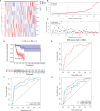Development and Validation of an Immune-Related Signature for the Prediction of Recurrence Risk of Patients With Laryngeal Cancer
- PMID: 34976784
- PMCID: PMC8716380
- DOI: 10.3389/fonc.2021.683915
Development and Validation of an Immune-Related Signature for the Prediction of Recurrence Risk of Patients With Laryngeal Cancer
Abstract
Objective: Our purpose was to develop and verify an immune-related signature for predicting recurrence risk of patients with laryngeal cancer.
Methods: RNA-seq data of 51 recurrence and 81 non-recurrence laryngeal cancer samples were downloaded from TCGA database, as the training set. Microarray data of 34 recurrence and 75 non-recurrence cancer samples were obtained from GEO dataset, as the validation set. Single factor cox regression was utilized to screen prognosis-related immune genes. After LASSO regression analysis, an immune-related signature was constructed. Recurrence free survival (RFS) between high- and low- recurrence risk patients was presented, followed by ROC. We also evaluated the correlation between immune infiltration and the signature using the CIBERSORT algorithm. The genes in the signature were validated in laryngeal cancer tissues by western blot or RT-qPCR. After RCN1 knockdown, migration and invasion of laryngeal cancer cells were investigated.
Results: Totally, 43 prognosis-related immune genes were identified for laryngeal cancer. Among them, eight genes were used for constructing a prognostic signature. High risk group exhibited a higher recurrence risk than low risk group. The AUC for 1-year was separately 0.803 and 0.715 in the training and verification sets, suggesting its well efficacy for predicting the recurrence. Furthermore, this signature was closely related to distinct immune cell infiltration. RCN1, DNAJA2, LASP1 and IBSP were up-regulated in laryngeal cancer. RCN1 knockdown restrained migrated and invasive abilities of laryngeal cancer cells.
Conclusion: Our findings identify a reliable immune-related signature that can predict the recurrence risk of patients with laryngeal cancer.
Keywords: immune; laryngeal cancer; prognosis; recurrence; signature.
Copyright © 2021 Zhang, Zhao, Wang and Ji.
Conflict of interest statement
The authors declare that the research was conducted in the absence of any commercial or financial relationships that could be construed as a potential conflict of interest.
Figures









Similar articles
-
Development and Validation of a Hypoxia-Related Signature for Predicting Survival Outcomes in Patients With Bladder Cancer.Front Genet. 2021 May 26;12:670384. doi: 10.3389/fgene.2021.670384. eCollection 2021. Front Genet. 2021. PMID: 34122523 Free PMC article.
-
Development and Validation of an Individualized Immune Prognostic Signature for Recurrent Prostate Cancer.Comb Chem High Throughput Screen. 2021;24(1):98-108. doi: 10.2174/1386207323666200627212820. Comb Chem High Throughput Screen. 2021. PMID: 32593277
-
Identification and validation of methylation-driven genes prognostic signature for recurrence of laryngeal squamous cell carcinoma by integrated bioinformatics analysis.Cancer Cell Int. 2020 Sep 29;20:472. doi: 10.1186/s12935-020-01567-3. eCollection 2020. Cancer Cell Int. 2020. PMID: 33005105 Free PMC article.
-
A Novel Set of Immune-associated Gene Signature predicts Biochemical Recurrence in Localized Prostate Cancer Patients after Radical Prostatectomy.J Cancer. 2021 May 1;12(12):3715-3725. doi: 10.7150/jca.51059. eCollection 2021. J Cancer. 2021. PMID: 33995646 Free PMC article.
-
Development and Validation of a Prognostic Gene Signature Correlated With M2 Macrophage Infiltration in Esophageal Squamous Cell Carcinoma.Front Oncol. 2021 Dec 3;11:769727. doi: 10.3389/fonc.2021.769727. eCollection 2021. Front Oncol. 2021. PMID: 34926275 Free PMC article.
Cited by
-
IBSP Promotes Clear Cell Renal Cell Carcinoma Progression Through the PI3 K/AKT Pathway.Biochem Genet. 2025 Apr 26. doi: 10.1007/s10528-025-11115-1. Online ahead of print. Biochem Genet. 2025. PMID: 40285946
-
Natural Killer Cells in Cancers of Respiratory System and Their Applications in Therapeutic Approaches.Immun Inflamm Dis. 2024 Nov;12(11):e70079. doi: 10.1002/iid3.70079. Immun Inflamm Dis. 2024. PMID: 39588940 Free PMC article. Review.
-
Downregulation of RCN1 inhibits esophageal squamous cell carcinoma progression and M2 macrophage polarization.PLoS One. 2024 May 7;19(5):e0302780. doi: 10.1371/journal.pone.0302780. eCollection 2024. PLoS One. 2024. PMID: 38713738 Free PMC article.
-
Integration of immune and hypoxia gene signatures improves the prediction of radiosensitivity in breast cancer.Am J Cancer Res. 2022 Mar 15;12(3):1222-1240. eCollection 2022. Am J Cancer Res. 2022. PMID: 35411250 Free PMC article.
-
Expression signature and prognostic value of CREC gene family in human colorectal cancer.BMC Cancer. 2023 Sep 18;23(1):878. doi: 10.1186/s12885-023-11303-5. BMC Cancer. 2023. PMID: 37723418 Free PMC article.
References
-
- Zhu X, Heng Y, Zhou L, Tao L, Zhang M. A Prognostic Nomogram for Predicting Risk of Recurrence in Laryngeal Squamous Cell Carcinoma Patients After Tumor Resection to Assist Decision Making for Postoperative Adjuvant Treatment. J Surg Oncol (2019) 120(4):698–706. doi: 10.1002/jso.25614 - DOI - PubMed
LinkOut - more resources
Full Text Sources
Miscellaneous

